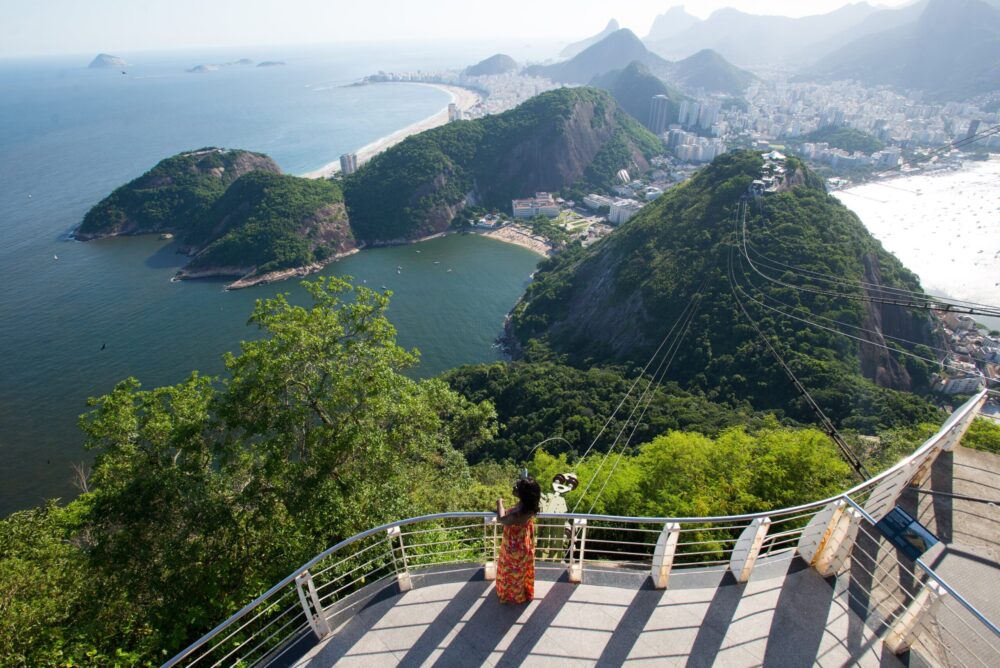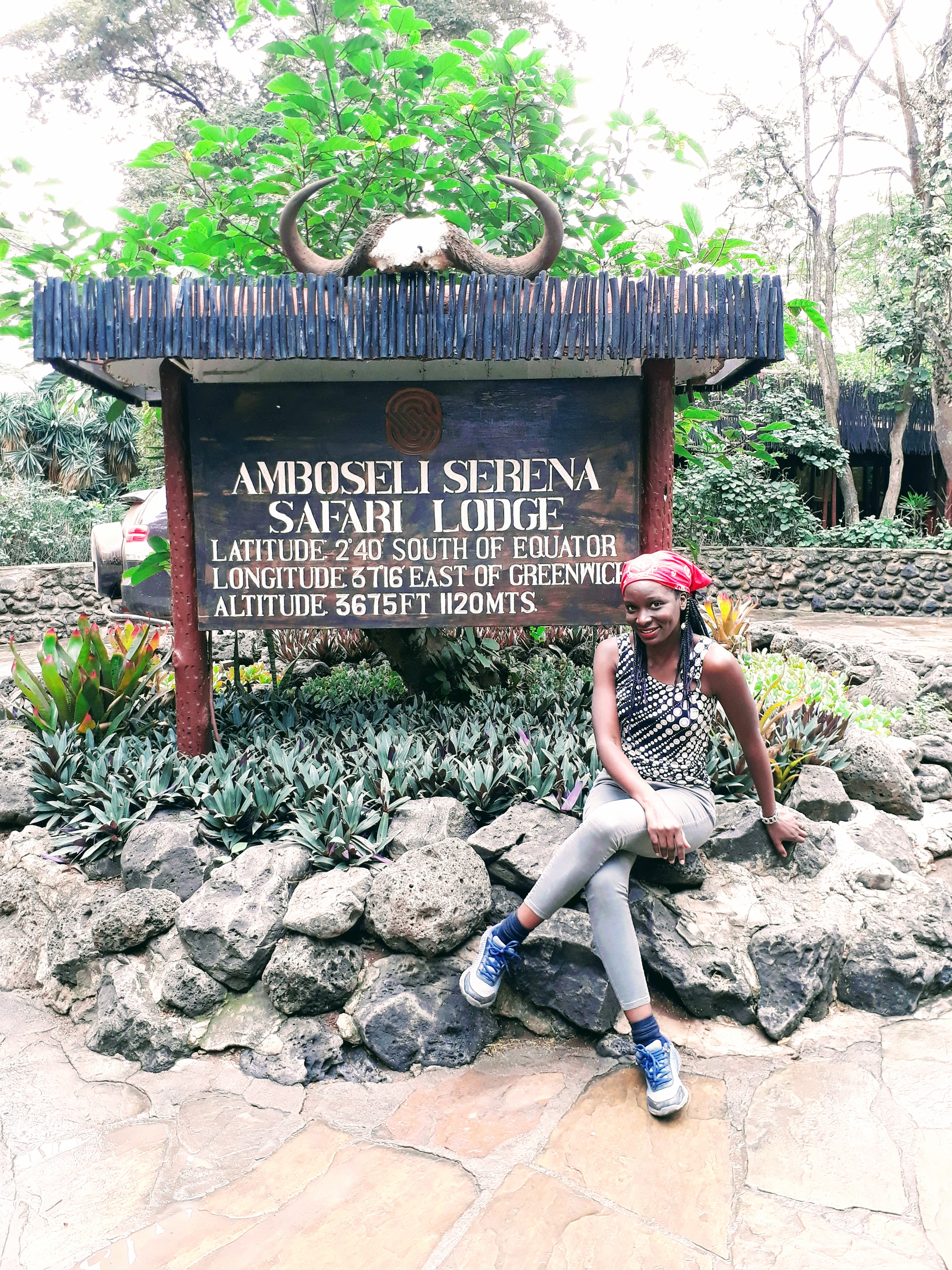
The wardens were however kind to us and allowed us to cross over to the other side.
In about an hour or so, we found ourselves at Kimana. But our guesthouse was a further 4 KM from Kimana Gate.
As we wound our merry way to the guesthouse through the barely non-existent narrow road bordered by thick bush, it was hard to shove aside the park warden’s last words.
Even though we had only met a few squirrels and hares here and there.
“Kindly note that it’s already after 6 pm and you will be driving through a protected area.
That means you will most likely run into wild animals.” “Switch off the car and wait until the animal departs,” he advised.
The logic being that the elephant could interpret the rumbling sound of the car’s engine as a threat.
Eventually, I just stopped thinking of what could be and decided to stare out of the car’s window and study the sky.
I clearly remember the eerie darkness that draped over it like a pitch-black curtain.
The stars were not visible that night.
Only the golden glow of the moon illuminated the atramentous curtain of sky.
The gleaming, globe-gold disc sat against the blackness like a melted platinum tattoo on the sky.
She gazed down at me with love so fierce it warmed my heart like a fireplace on a freezing July night.
The look that she gave me burned away my worries with a rush of relief.

But just for a moment.
My head snapped in an instant from gazing out of the window to a giant silhouette that loomed in the distance, interrupting my train of thought. It grew larger as we moved closer.
On close inspection, it appeared like an elephant. The horizon that moments ago was mild and gentle revealed an intense, savage stance.
I picked my eyes off the silhouette with the weariness of a husband who is fatigued by the nagging of his beloved wife and focused on the driver.
What surprised me was that he kept moving.
At this point, the distance of separation between us is about 4 feet and I can no longer hold my peace.
“Turn off the engine! An elephant!” I screamed out loud.
As male elephants usually live alone or in small groups, and only join the females temporarily during estrus, I assumed he was male.
“Here in Amboseli, it is a sin not to see elephants”, the words the warden had muttered in passing came into fore.

Surprised by our unexpected presence as we were by his, he planted his feet firm on the ground and stood still.
All alone right in the middle of the road staring at us.
His thick baggy coat was gray in color, wrinkled, and had sparse hairs.
He had a heavy body with a long trunk, large ears shaped like the continent of Africa, gigantic cylindrical legs with cushion-like soles, and small eyes.
The silence that followed ranks as one of the most spine chilling and simultaneously thrilling moments I experienced on this two day safari tour from Nairobi to Amboseli.
I feared for our lives when the elephant begun skulking up towards the car.
After just one step, he lost interest in us, moved away from the road, and walked away into the thicket.
A sight of relief and it was over. It froze my marrow to think that he could have decided to keep walking towards us!
Goodness gracious!
With the road now clear, we hastily made our way to our accommodation in Amboseli for some well-deserved sleep.
Amboseli is well known as the best spot in the world to get up close to free-roaming African elephants in their natural habitat. buffalo, impala, lion, cheetah, hyena, giraffes, zebra, wildebeest among other African animals.

But Amboseli aka “The Kilimanjaro Royal Court” is more than the treasure-trove of delights it keeps on the Savannah and woodlands.
The park’s border to the south is wrinkled with the snow capped peaks of Mount Kilimanjaro, Africa’s highest peak.
On a good cloudless day, the peaks enhance your game viewing display and provide a spectacular photography background. Amboseli is also your gateway to Arusha or Moshi in Tanzania.
This Amboseli Safari guide includes a 2 day 1 night sample itinerary, must visit must do things in Amboseli, a summary of expenses, etc.
What's Covered in This Article
About Amboseli
Amboseli National Parks is one of Kenya’s most popular parks. It covers covers 392km² (151miles²).
The name “Amboseli” comes from a Maasai word meaning “salty dust”.
Nature lovers can explore five different habitats here ranging from plains, acacia woodland, rocky thorn bush, swamps and marshes.

Thanks to its proximity to Nairobi (only 5 hours away), it has become an ideal destination for nature lovers, safari enthusiasts, and visitors to Kenya pressed for time who may be a bit hesitant to tour other safari destinations at the far corners of the country.
The hidden wonders it keeps in its depths are no longer secret, but they continue to amaze curious souls.
- Language: Maa, Swahili, and English
- Currency: Kenya shilling (KES). KES100 is around USD 0.99, EUR 0.84 (as of June 2018).
- Modes of payment: Cash! While the luxury and standard level lodges accept debit credit cards, the smaller budget establishments prefer cash. There are a few banks with ATM in the town proper of Namanga and Emali, but it would be best to have cash on hand even before leaving Nairobi.
- Sim Card or Phone: As it is usually pay as you go, simply buy a local Airtel, Safaricom, or Telekom sim card with data and then use it as a WiFi hub for other phones and laptops. A local Sim card goes for 100 KES (about 1 USD). You will need to show your Passport to, and have a photograph of you taken by, the respective vendor to have the SIM Card registered. Safaricom is the more expensive one but has the best nationwide coverage. Airtel is the cheapest with different unlimited data, phone, and SMS bundles. Telekom has the worst coverage but the best in call quality.
- Amboseli National Park Entrance Fees (Payable strictly by card or M-Pesa):
- Non-Resident Adults USD 60
- Citizen Adults KSH 860
- Electricity Info: 240V, 50Hz. Socket Type G, mostly.




Best Time to Visit Amboseli
When is the best time to visit Amboseli? January and February are great months to visit Amboseli National Park for safari. June to September is also a good time to visit Amboseli.
The best months for birdwatchers to see migratory birds birdwatching in Amboseli are October through January.

Like most parts of Kenya, Amboseli experiences two seasons: dry and wet.
The months of January to February and June to September are the driest, while April and May, and November to December, are the the most rain-drenched which may make the roads in Amboseli impassable.
Because of Amboseli’s relative closeness to Nairobi, its lodges and campsites can fill up with tourists quite easily. Hence, even January to February and November to December, are the peak tourist seasons at Amboseli due to the good weather.
As it can be pretty crowded, If you must visit in these months, book your accommodation in Amboseli in advance.
How to Get to Amboseli from Nairobi

If you’re going by road, here’s how to get from Nairobi to Amboseli National Park:
By Road:
1. Use your own vehicle via Namanga.
- If staying close to Kimana Gate, take Mombasa Road up to Emali, then Loitokitok road to Kimana.
- If staying close to Meshanani (Kelunyiet) Gate, take the tarmac road from Nairobi to Namanga (240km/149 miles). Branch off at the Namanga Amboseli road which takes you to the Meshanani (Kelunyiet) Gate (about 50 KM of unpaved road).
- Travel time from Nairobi to Amboseli is about 5 hours.
2. Book a safari tour
3. Take public transport from Nairobi to Amboseli
- Take an Oloitoktok bound shuttle / matatu from Nairobi. Kimana Gate is about 20 km before you reach Loitoktok. Once in Kimana area, get a boda boda (motor taxi) to your camp site or lodge. Alternatively, call your accommodation to pick you up.
- The matatu terminal for Oloitoktok Amboseli Kimana matatus in Nairobi CBD is at OTC, Ronald Ngala street opposite former Jack and Jill supermarket just after the Ronald Ngala post office – near the petrol station where the route 45 buses stop.
- Travel time from Nairobi to Emali by matatu is around 2.30 Hours at 50 KM per Hour.
- Fare is about KES 400.
4. SGR Train from Nairobi to Amboseli.
- Try to leave in the early morning to arrive Amboseli in good time for an evening or afternoon game drive.
- The SGR train terminal in Nairobi is at Syokimau on Mombasa Road CBD.
- In Nairobi, catch the commuter train from the CBD railway station at 6:10 am and drop off at the Nairobi Terminus in Syokimau area for Ksh. 50
- Take the Mombasa bound inter-county SGR train from Nairobi Terminus and get off at Emali, the second stop.
- Once at Emali, take
- Travel time: 60 minutes. Fare: KES 260.
By Air:
You can either charter a light aircraft that will drop you off at the airstrip at Empusel Gate, Namanga or Kilimanjaro Buffalo Lodge; or take . You can also book a scheduled flight departing from Nairobi to Amboseli.
Where to Stay in Amboseli
The main type of luxury and standard level accommodation in and around Amboseli National Park are the safari lodges and tented camps.
If on a budget, then stay at a tented camp or cabin. There are dozens dotting the map of Amboseli, some of them providing camping gear while others you have to bring your own camping gear. Note that other than the Amboseli public camp site, all the other camp sites and lodges are outside the park towards Kimana gate.
We stayed at WE4Kenya Guesthouse just 4 KM from Kimana Gate during our visit.

- Ol Tukai Lodge Amboseli. Check Rates & Availability.
- Sentrim Amboseli Lodge. Check Rates & Availability.
- Kilima Safari Camp. Check Rates & Availability.
- WE4Kenya Guesthouses. Check Rates & Availability.
- Kibo Safari Camp. Check Rates & Availability.
- Maasai Simba Camp. Check Rates & Availability.
- AA Lodge Amboseli. Check Rates & Availability.
- Tawi Lodge. Check Rates & Availability.
- Satao Elerai. Check Rates & Availability.
Other more luxurious options include lodges such as Ol Tukai lodge Amboseli, Amboseli Serena lodge, among others.

| AMBOSELI NATIONAL PARK | |
| Luxury lodges/ tented camp accommodation | Ol Tukai lodge Amboseli, Amboseli Serena lodge |
| Standard lodge/ / tented camp accommodation | Amboseli Sopa Lodge, Tawi Lodge, Sentrim Amboseli Lodge, Kibo Safari Camp |
| Budget / camp accommodation | WE4Kenya Guesthouses, AA Lodge Amboseli Amboseli Junction Hotel, Maasai Simba Camp, Kilima Safari Camp, Satao Elerai, Olgulului Public Campsite, Abercrombie and Kent Tented Camp, Ker and Downy Tented Camp, Chyulu Tented Camp, Kimbla Campsite, Cottar’s Tented Camp, Leopard Tented Camp and Tortilis Tented Camp. |
SEARCH FOR MORE: ACCOMODATION IN AMBOSELI
What to see, what to do at Amboseli National Park

Maasai Village Tour to learn about the Maasai culture and their indigenous lifestyle
The Maa peoples are the native inhabitants of Amboseli. Thus, there are several Maasai houses, traditionally known as manyattas, and settlements around the park.
A manyatta is a hut made of mud and cow dung with a grass thatched roof. For ventilation and lighting, a tiny hole is engraved in the wall.

When you are on a game drive you will occasionally come across the site of recently dismantled manyattas, with the layout of the village clearly marked out as dark patches on the ground
Visiting a Maasai village is the best way to become better acquainted with Maasai culture and their indigenous lifestyle, see the inside of their houses, learn how they make fire, their staple foods, their nomadic lifestyle, etc.
The villages are often a collection of (frequently, but not necessarily) round houses walls made of mud and cow dung with conical roofs made of grass.
Generally, communities of several families would build their Manyattas inside a wall enclosure made of thorn barrier making up one village. In the middle of the enclosure would be a place for the animals.
Most Maasai lead a nomadic pastoralist lifestyle, they follow the grazing land for their livestock.
Thus, traditionally, Manyattas aren’t permanent settlements and will be moved.
When the animals exhaust a given grazing land, they dismantle the Manyattas and move the village to a new place with greener pasture.
Before heading out to a Maasai village, please consult with your lodge or camp management.
Maasai Village Tour Costs: Usually it costs about $20 (KES 2,000) per person to visit a Maasai Village.
If staying at the WE4Kenya Guesthouses, there is a Maasai Village just outside the compound.

Game Drive in Amboseli National Park
Amboseli National Park is the best place for an early morning or afternoon game drive with a perfect view of Africa’s highest mountain, Kilimanjaro for a magnificent backdrop.
In Amboseli you will see vast herds of free-roaming African elephants accompanied by colonies of other phenomenal animals like the flamingos, lions, buffalos, hyenas, giraffes, gazelle, hippos, and wildebeests to name but a few.

View the Peaks of Mount Kilimanjaro
If you are lucky to be visiting Amboseli on a cloudless day, then you will get a chance to view different peaks of Mount Kilimanjaro, the highest freestanding mountain in the world.

Visit Normatior (Observation Hill) for a 360 degree view of Amboseli
Another must see do activity in Amboseli is visiting Amboseli Observation Hill – the highest point in the park – for spectacular front row seat view of Mount Kilimanjaro, the wet swampy lands, and the herds of free-roaming animals far away below.
This is the same spot where his is where Dennis, Karen Blixen’s lover crashed to death.
Take advantage of the information boards scatted around the hill for information about the park and it’s history.
At the base hill you will also find decent washrooms for your convenience.
A word of caution though.
It is a bit of a short climb up stone steps, but well worth it for amazing the views over the park.
Worth noting also is the fact that Observation Hill is one of the only places in the park where you can get out and walk.
This makes it a making it a great place for a champagne breakfast or picnic lunch.
It therefore can get very crowded but, most groups leave as soon as they’ve completed their meal.

Bird watching
Amboseli is also perfect for avid bird watching.
Sample 2 Day, 1 Night Amboseli Safari Tour Itinerary
Below is a sample weekend itinerary to Amboseli National Park. Tweak it to suit your schedule and needs.
Day 1: Nairobi – Amboseli National Park
07:00 am – Depart Nairobi for Amboseli National Park (230 km)
13:00 pm – ETA in Amboseli, check-in and lunch, rest, freshen up, prep for afternoon game drive
15:30 pm – Introductory late afternoon game drive in the park
18:00 pm – Leave park
19:30 pm – Dinner
10:00 pm – Lights out /overnight at camp / lodge.
Day 2: Amboseli National Park – Nairobi / Namanga
05:30 am – Wake up
05:45 am – Breakfast (if applicable), Sunrise viewing
06:30 am – Early morning game drive
10:00 am – Exit park and proceed to the lodge for breakfast (if applicable) and check-out
12:00 pm – Visit Maasai village
13:00 pm – ETD Amboseli
19:00 am – ETA Nairobi
Bonus Travel Tips
- Try to leave in the early morning to beat Nairobi traffic and also to arrive Amboseli in good time for an evening or afternoon game drive.
- Beware of herds of cows that occasionally cross the roads especially around Il Bisil areas causing blockages

- Carry a debit or credit card even if you prefer your park entrance fees by M-PESA. During our visit to Amboseli, the phone networks were down so M-PESA couldn’t work and we had to pay the park entrance fees by card.
- Please remove geo-tag location from photos of endangered animal species elephants and rhinos, before posting on social media. Poachers currently leverage the internet to locatethe animals!
- Leave some form of gratuity when you visit the Maasai villages.
- Do not take pictures of the Maasai without their express permission.
- The bigger your group, the cheaper the per person expenses for the tour.
- Stay at WE4Kenya guesthouses and Farm while visiting Amboseli. It is perfect for Backpackers and travelers on a budget looking for an authentic stay just outside the park in a serene environment surrounded by nature and close to the friendly local Maasai community. Accommodation at WE4Kenya is a mix of tented camps, cabins, and tents. WE4Kenya is 4 KM to the Amboseli National park on a good cloudless day you are treated to views of majestic looking Kilimanjaro from the comfort of your tent or guesthouse. I love that they are eco-conscious. They use solar power for lighting and serve freshly made food daily using ingredients from the local market (and their small farm). Oh, and kids under 12 stay free.

Have you been to Amboseli? How was your experience like? Let’s continue the conversation in the comments below.




